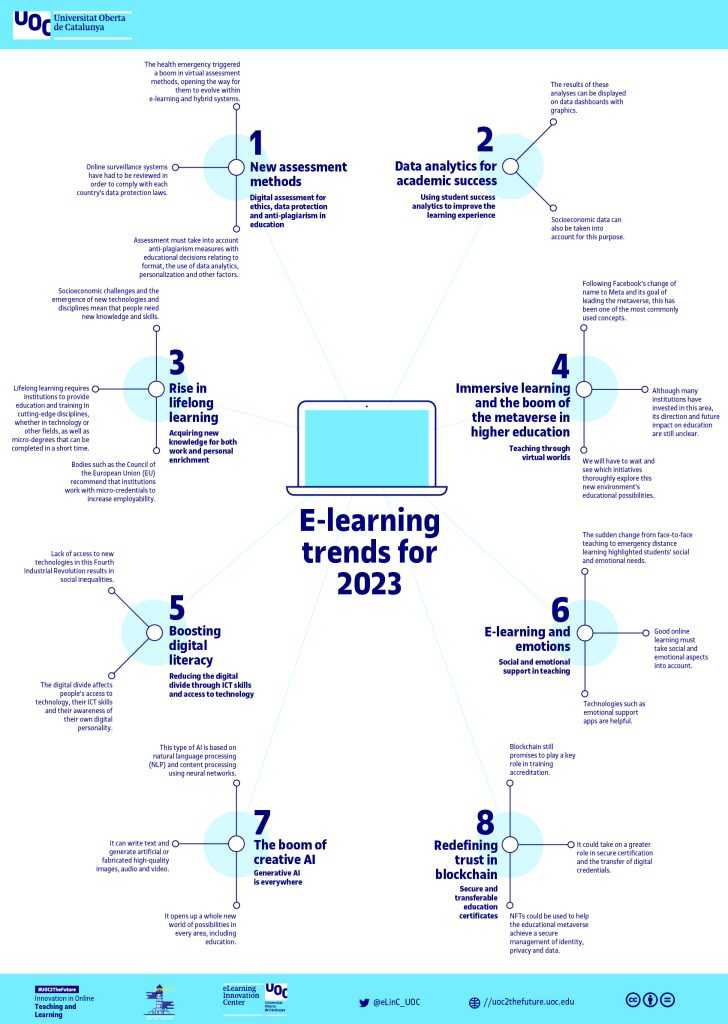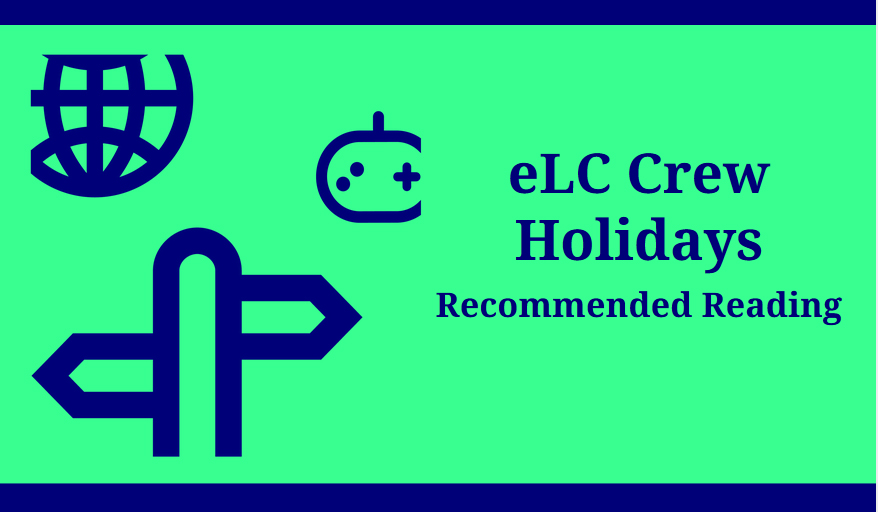The eight top trends in e-learning for 2023
23 December, 2022 Photo by Lukas Blazek on Unsplash
Photo by Lukas Blazek on Unsplash
The challenges of digital assessment, data analytics to improve student experience and success, and issues related to lifelong learning, such as the need to offer microcredentials, are some of the top trends in e-learning for 2023.
It’s a year that will see a continuation of trends from the previous year, such as the role of blockchain in the accreditation process, and some arising during the pandemic, such as social-emotional learning for students. In this article, Guillem Garcia Brustenga and Desirée Gómez Cardosa, from the UOC’s eLearning Innovation Center (eLinC) Trend Spotting and Analysis team, look at eight top trends in e-learning.
New forms of assessment: digital assessment with an ethical perspective, data protection and anti-plagiarism pedagogies
The COVID-19 pandemic increased the importance of online assessment methods, a trend that is faced with challenges, such as the data protection laws in each country. This has made it necessary to review online monitoring systems. Examples of such systems, which were vital in enabling assessment and continuity during the pandemic, are Examity and Proctortrack, adopted by Queen’s University in Canada. They are becoming more and more widely accepted by students and allow online assessment in institutions that are increasingly using e-learning or hybrid models.
Many academics have stressed the need for assessment systems to have anti-plagiarism measures in place. Sometimes this depends on pedagogical decisions about the format: for example, avoiding multiple-choice questions and questions that have a simple answer. Another example is the assessment project at the University of Exeter in the UK, which includes data analytics in exams by personalizing the tests.
Data analytics for academic success
Universities are increasingly using data analytics on student activity to improve the student experience, aid academic success and also take socio-economic data into account. One example is the University of Maryland, Baltimore County (UMBC), which uses analytics and translates them into data plans with graphs.
In the United States, a project by the Association of Public and Land-grant Universities (APLU) and the Institute for Higher Education Policy (IHEP), Using Data to Increase Student Success, has conducted 14 case studies in colleges and universities, highlighting how higher education institutions are driving progress on campus through the effective use of student data. Examples include Colorado State University and Georgia State University.
The Educause association has set up a working group with specialists to promote the study of data analytics and student success. The group has developed a framework for the analysis of student success based on four components: preparation, results, analysis and decisions.
Increasing lifelong learning
The world’s constant socio-economic challenges at many levels and technological progress push people to reskill and adapt to new knowledge, leading them to study throughout their working lives, known as lifelong learning. Institutions are called upon to offer leading disciplines in the fields of technology or other fields and micro-qualifications in a short period of time.
On 16 June 2022, the Council of the European Union (EU) adopted a recommendation on a European approach to microcredentials for lifelong learning and employability. This document aims to support the development, implementation and recognition of microcredentials across institutions, businesses, sectors and borders.
Known as digital badges, microcredentials are collected through applications, websites or data systems. They tend to represent shorter and more specialized learning than a traditional diploma, degree or certificate.
Immersive learning and the rise of university metaverses
When Facebook announced in 2021 that it was going to become Meta and lead the metaverse, the concept became one of the most widely used during the year. However, it is still unclear where this will lead and what impact it will have on education. So far, we have not seen many initiatives in this area – just something along the lines of what Second Life was a decade ago, for example at the Monterrey Institute of Technology or at Stanford, both focusing on browsing and without fully exploring the pedagogical possibilities that the new environment can surely offer.
Higher education institutions also face many questions. What will the educational metaverse look like? Will there be virtual reality devices? Will there be avatars? What will it contribute to education? What are the educational possibilities we mentioned? To explore these and other possibilities, the UOC’s eLinC commissioned a report from expert Marc Cortés, which highlights the potential impact of the educational metaverse in four areas: models and processes; matching supply and demand; redesigning environments; and ecosystem-based models.
Strengthening digital literacy
In the article “A major challenge for e-literacy: the gender digital divide“, we outlined the consequences of the lack of access to new technologies for the population in a society immersed in the industry 4.0 revolution. The digital divide affects not only access to technologies, but also the possession of functional skills in terms of ICT competencies, as well as digital personality awareness, among other things.
UNESCO’s strategy for youth and adult literacy (2020-2025), which is aligned with Sustainable Development Goal 4 (SDG 4) on Quality Education and the Education 2030 Agenda, highlights the importance of paying more attention to digital literacy skills and ensuring links between literacy and other knowledge, skills and competencies, including global citizenship, vocational skills, and media and information literacy.
E-learning and emotions: pedagogical methods that support the socio-emotional side
During the transition from face-to-face teaching to emergency remote learning, a strong focus was placed on the socio-emotional side of the student. Since then, many studies have been conducted.
The article “Student Emotions in the Shift to Online Learning During the COVID-19 Pandemic” (Espino et al., 2021) highlights that the distress felt by students during the pandemic was connected to the course format, focus and workload. This is indicative of the difficulties students had in staying focused and balancing tasks in learning activities during lockdown.
To avoid these situations, effective online learning must be based on pedagogical methods that support students, place them at the centre of the learning experience and understand the affective and emotional factors. More and more institutions are working on this dimension, and pedagogical methods such as social-emotional learning (SEL) help students not only to develop their emotions, but also to be empathetic and make decisions to deal with challenges, which are key factors in remote learning.
Technology is a useful aid in this area, and during the pandemic and afterwards many universities have encouraged students to use mobile apps for emotional support, such as the University of Michigan, which recommends SilverCloud, an app that helps manage stress and anxiety.
Generative AI boom: AI goes mainstream
We will have to keep an eye on the evolution of generative or creative AI based on natural language processing (NLP) and mass processing of training content using computing techniques such as machine learning and neural networks. Projects such as DALL-E and GPT-3 (two open-source projects from OpenAI, an organization co-founded by Elon Musk and controlled by Microsoft) have become very popular, as well as many other projects that allow for the “creation” of completely original content. Some are in the early or research stages, but they range from writing text of all kinds to synthetically or artificially generating high-quality images, audio and video from textual input ideas.
This opens up endless possibilities in all sectors, including education. However, it also raises many questions and opens up many debates that need to be addressed. What is the quality or reliability of a text generated by AI? Can AI create art? And knowledge? How does it affect copyright? What impact will it have on certain professions?
Redefining trust in the blockchain
In 2023, the trend remains that blockchain will be a key part of the whole process of accreditation of lifelong learning and that the role within the certification of microcredentials, nanodegrees, digital accreditations and badges will be strengthened. In this respect, blockchain technology can be a very useful tool for managing digital identity and trust in certification and accreditation processes.
Furthermore, there is talk that blockchain and NFTs (non-fungible tokens) could be the key to taking the educational metaverse a step beyond the Second Life experience by facilitating traceability, certification and governance to enable secure management of identity, privacy and learning data.









